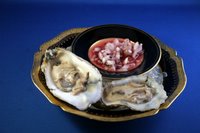Wegmans Great Oysters


The oysters pictured at top left are Gerrish Island oysters from Wegman’s. Those at bottom right are Pepperell Cove oysters from Wegman’s. Each is being served with a mignonette sauce, easily made by combining ¼ cup of shallots with 1/3 cup of red wine vinegar, then adding a teaspoon of coarsely cracked peppercorns and a large pinch of kosher salt.
We commented on these two kinds of oysters when describing the quest for bounty to grace the Christmas dinner table. The man working Wegman’s seafood counter had noted that both were from Maine. He was right. They came from Maine, but neither originated there.
The Gerrish Island oysters had a shape more rounded than the Pepperell Cove’s. Distinguishing the Pepperell Coves was a bit of grassy green coloration in their shells. The man at Wegman's informed that the Pepperell Cove’s should taste a bit more salty or briny.
A quick google confirmed that both Gerrish Island and Pepperell Cove were Maine locations. Both oysters, when opened, proved wonderfully juicy and briny. In fact, they tasted almost identical. Needless to say, by Christmas, all three dozen oysters had been consumed.
Several days later, parked along Pulaski Highway in Baltimore County, was a white truck from which two kinds of oysters were being sold. The choice was between Delaware Bay oysters and Canadian oysters from Prince Edward Island. The $15.00 price for two dozen Prince Edward Island oysters seemed well worth the money. We were intrigued over how much they looked like Pepperell Cove oysters. When opened, they were salty and delicious with a slightly different flavor, also less juicy and a bit meatier. It was a close call, but we preferred the Pepperell Coves.
Further research led to the website of Spinney Creek Shellfish, Inc. in Eliot, Maine. It advertised Pepperell Cove oysters from Prince Edward Island, and Gerrish Island Oysters from "Mid-Atlantic waters." Then a google of "Prince Edward Island oysters" suggested that the vast majority of oysters from Prince Edward Island were sold as Malpeques, in conjunction with PEI's Malpeque Bay, which has long been famous for its oysters. Could the oysters from the truck on Pulaski Highway have been Malpeques? For that matter, were all oysters from Prince Edward Island actually Malpeques? And what about the Pepperell Cove Oysters? The purveyor at the truck on Pulaski Highway had registered a blank when asked.
Ultimately Lori Howell, one of the principals at Spinney Creek Shellfish, Inc., provided all the answers that were needed by telephone. She explained how her company is in the business of sourcing Atlantic oysters that are brought to its Maine depuration facility.There they are placed in tanks of sterilized Maine seawater for cleaning and later tested at the company’s labs for safety and quality. Then the company brands its oysters. Those from Prince Edward Island are branded with the name Pepperell Cove; The Delaware Bay Oysters are branded as Gerrish Island oysters. When asked if the Pepperell Cove oysters from PEI were in fact Malpeques, Ms. Howell explained that Malpeque was another brand name granted exclusively to producers on Prince Edward Island.
The bottom line, Ms. Howell explained, is that all native North American oysters from waters linked to the Atlantic, including the Gulf of Mexico, are one and the same in terms of species: Atlantic oysters. Differences in taste and flavor are determined by the composition of the waters that nourish them. Differences in size and shape relate to the numerous types of underwater bed or bottom surfaces where they spawn and grow. An oyster filters 96 gallons of water a day from which it obtains its nutrients. Needless to say that after spending a number of hours in a tank of sterilized Maine seawater, a Prince Edward Island oyster is going to look the same but taste quite different than when it left Canada. The same can be said for oysters from Delaware Bay or anywhere else.
Here in Baltimore, everyone knows how Chesapeake Bay oysters, rendered more briny after having been placed into Chincoteague waters, were sold as Chincoteagues. The Chesapeake and Chincoteague oyster harvests have fallen on hard times over subsequent decades. Meanwhile, companies like Spinney Seafood, Inc. are increasingly filling the void.
